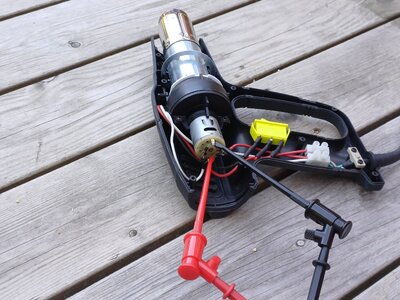Grossel
Well-Known Member
Hi. I have this simple hot air gun that have a fault where the blower motor suddenly runs slower mid operation for no obvious reason.
Disclaimer: When I describe the loss in power and try to put a number on it (i.e. half power) - this is only due to audible sound, vibrations etc. that can be felt. No measurements involved and the actual loss of power might hold a different value.
Key features of heat air gun
This is the observed faults so far
Key points (I've learnt this from AI, not being an AI myself - but who can really tell nowdays)
Ok - all of the above is facts, as observed. I've thinking that I have 2 suspected fault causes, but still doesn't have good measurement to pin point the actual cause. Hopefully some have some experience with heaters that can shed some light on this.
Motor failure (theory one)
This is just a simple DC motor with permanent magnets. If this is the failure point, the measurements can be explained: Winding on the rotator inside the motor being shorted. This will cause the dc motor to run less effectively. The voltage drop may therefore be caused by fewer windings.
Faulty connection within the heater element (theory two)
This may also cause a voltage drop to the motor.
What do you guys deduce from this information? What is more likely to be the point of failure, the motor or the heater (some failure within) ?
Disclaimer: When I describe the loss in power and try to put a number on it (i.e. half power) - this is only due to audible sound, vibrations etc. that can be felt. No measurements involved and the actual loss of power might hold a different value.
Key features of heat air gun
- Simple DC motor + diode bridge. Most probably connected in series to some heat element within the heater.
- Heater design: Unknown. Don't know if any connection issue within the heater may be the cause.
- Power switch, 3 states - OFF, power.sw.pos. 1 (less heat and slower fan) and power.sw.pos. 2 (2kW heating and air blower goes full speed)
- Fully insulated - there is no ground connection (230VAC)
This is the observed faults so far
- While normal operation, about 5 minutes of use (power sw pos. 2 ~2kW): Speed of motor drop to about half power. The temperature seems to remain the same, but no measurement so can't be sure. Moving the power sw. to pos 1 - the motor still runs much slower than expected. After device being cooled down, starting the device in power.sw.pos. 2, it runs normal again.
- Test run (see picture) - DC voltage being measured over the dc motor using an analog voltmeter (all test performed when power.sw.pos. 2): First run the motor DC voltage are stable at ~18V. However this was measured in semi faulty state, because after power off and on again caused the motor speed to run slightly faster (normal speed) and the DC voltage over the motor was now 20V.
- This means that (at least in this semi faulty state) - the voltage over the motor drop compared to when it operate in non-faulty state.
- Test run with clamp amperemeter (6A range). Motor seems to run just fine, cannot tell if it runs at full speed or slightly slower. Motor draws about 1.4A (slightly below according to the needle). However, I was not able to re-produce the fault so I cannot tell if the amperage also goes down on fault or not (it ran for over an hour at 2kW, I started the unit over again ten times during that time - but still failed to reproduce the fail state)
- When the device goes in fault state - the speed of the blower motor remains stable. The fault state does NOT cause the DC blower motor to run erratically.
Key points (I've learnt this from AI, not being an AI myself - but who can really tell nowdays)
- The faulty state are hard to reproduce, but seems to be more likely to occur under normal use (when device being held by hand) as opposed when it lays down on the ground (being tested).
- Fault state can behave different from time to time, some times the motor speed is just slightly reduced, but other times the fan speed goes at half speed.
- Speed remains stable in faulty state.
- Voltage over motor drop when in fault state. Don't know if current drops or stay the same (and therefore unable to tell for sure if the fault is in the motor itself).
Ok - all of the above is facts, as observed. I've thinking that I have 2 suspected fault causes, but still doesn't have good measurement to pin point the actual cause. Hopefully some have some experience with heaters that can shed some light on this.
Motor failure (theory one)
This is just a simple DC motor with permanent magnets. If this is the failure point, the measurements can be explained: Winding on the rotator inside the motor being shorted. This will cause the dc motor to run less effectively. The voltage drop may therefore be caused by fewer windings.
Faulty connection within the heater element (theory two)
This may also cause a voltage drop to the motor.
What do you guys deduce from this information? What is more likely to be the point of failure, the motor or the heater (some failure within) ?


